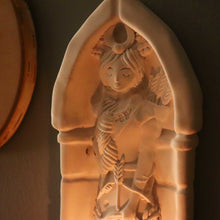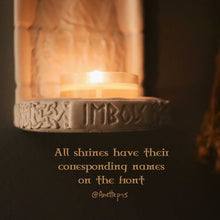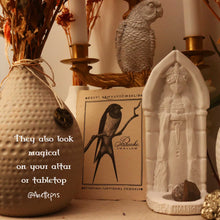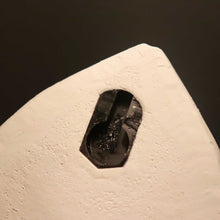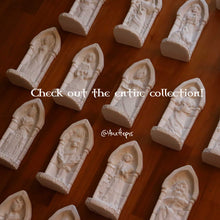
Handmade with love in Estonia, available in limited quantity.
This small shrine can be hung on your wall to bless your home, or placed on any table-top, whether it be your tv table, next to your bed, or anywhere else!
The engraved circle in front is suitable for a standard tea-candle. You can also place water or other offerings there, the possibilities are endless!
Made from high quality plaster that looks and feels like clay.
Size:
Width: 8cm / 3 inches
Height: 20cm / 8 inches
Candle holder part: reaches out by 7.5cm / 3 inch
—
Artemis is among the most ancient indigenous spirits of Greece. Her earliest incarnation seems to have been as a bear goddess. By the Classical Era, Artemis was absorbed into the Olympian pantheon as the spirit most associated with wild nature, witchcraft, and women’s mysteries. Artemis was venerated by both men and women. She is an initiatory spirit who presides over rites of initiation for both males and females.
According to the most popular version of her myth, Artemis was born on the island of Delos, daughter of Leto and Zeus. Her very first act upon drawing breath was to assist Leto in the long, difficult delivery of her brother, Apollo. He is her complement and alter ego: spirit of the sun and masculinity in contrast to her as spirit of the moon and femininity. Artemis is a good friend and ally of Persephone.
Zeus offered Artemis her deepest wish: she requests never to be forced to marry. This may be understood as a demand to maintain autonomy and independence. Emphasis is often placed on Artemis’ chastity but her temple rituals involved erotic dancing and masquerades by men and women, not necessarily separately. Artemis’ sexuality is not under anyone’s control but her own. Her emphasis on chastity may hark back to a primeval bear cult in which sexual abstinence precedes the hunt.
Artemis is Mistress of the Hunt: she protects the wilderness from excessive human encroachment and regulates sacred hunting rituals. Artemis influences, grants, and removes human, animal, and botanical fertility. She regulates menstrual cycles.
Artemis rules sexual energy and tension. She presides over mysteries involving sexual energy intended for magical rather than procreative use. Sexual energy is concentrated, rather than released, to serve as a source of esoteric power.
Artemis was both loved and feared. Her name may mean “bear” but may also derive from Artamos, “slaughterer” or “butcher.” She preserves, bestows, and takes the lives of animals and people. She was among the last Greek deities to reject human sacrifices. She grants fertility to those previously unable to conceive but also decides who survives childbirth (women and animals). She is the gatekeeper who determines who lives and who dies.
• Artemis can bestow or withhold health, wealth, life, and fertility.
• She can undo any mischief caused by Nymphs or Nereids.
• Artemis may be petitioned for a swift death.
Veneration of Artemis was never entirely suppressed, nor was she ever as closely associated with malefic witchcraft as her Italian counterpart, Diana. Instead her spiritual functions were officially redistributed to male saints, especially Saint Nicholas but also Saint Artemidos, who emerged to take her place. Artemis survives in modern Greek lore: she still wanders the wilderness, but rather than leading a band of Nymphs, she is now Lady Beautiful, Queen of the wild Neraida.









